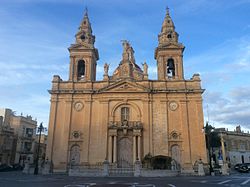Luqa
|
Luqa Ħal Luqa Casal Luca |
|||
|---|---|---|---|
| Local council | |||

|
|||
|
|||
 |
|||
| Coordinates: 35°51′35″N 14°29′21″E / 35.85972°N 14.48917°ECoordinates: 35°51′35″N 14°29′21″E / 35.85972°N 14.48917°E | |||
| Country |
|
||
| Region | Southern Region | ||
| District | Southern Harbour District | ||
| Borders | Birzebbuga, Għaxaq, Gudja, Kirkop, Marsa, Mqabba, Paola, Qormi, Safi, Santa Luċija, Siġġiewi, Tarxien, Zurrieq | ||
| Government | |||
| • Mayor | John Schembri (PL) | ||
| Area | |||
| • Total | 6.7 km2 (2.6 sq mi) | ||
| Population (March 2014) | |||
| • Total | 5,945 | ||
| • Density | 890/km2 (2,300/sq mi) | ||
| Demonym(s) | Ħalluqi (m), Ħalluqija (f), Ħalluqin (pl) | ||
| Time zone | CET (UTC+1) | ||
| • Summer (DST) | CEST (UTC+2) | ||
| Postal code | LQA | ||
| Dialing code | 356 | ||
| ISO 3166 code | MT-25 | ||
| Patron saint | St. Andrew | ||
| Day of festa | First Sunday of July (main feast) November 30 (liturgical feast) |
||
| Website | Official website | ||
Luqa (Maltese: Ħal Luqa, meaning poplar in Aramaic) is a village located in the Southern Region of Malta. It is an old town that has a dense population, typical of the Maltese Islands. The population of Luqa is 5,945 as of March 2014. There is a church in its main square dedicated to St. Andrew. The traditional feast of St. Andrew is celebrated on the first Sunday of July, with the liturgical feast being celebrated on the November 30.
Citizens of Ħal Luqa vote for their local council every three years, which council consists of seven members, one of them being the mayor. The Mayor of Ħal Luqa is John Schembri.
The famous clock maker and inventor Michelangelo Sapiano (1826-1912) used to live in Ħal Luqa. He constructed various kinds of clocks, the clock in the belfry of the Parish Church being one of his many works. The house in Ħal Luqa where he used to live in, is situated in Pawlu Magri Street.
Luqa was established as a separate Parish from that of Gudja on 15 May 1634 by a decree issued by Pope Urban VIII. In 1592 the village of Luqa was hit by Bubonic plague, which at that time hit all the population of Malta and caused many deaths. A sign of this sad episode is the cemetery found in Carmel Street, Alley 4 where people were buried in a field changed into a cemetery.
Another sad tragedy for Ħal Luqa was the cholera epidemic of 1850 where 13 people lost their lives. A cemetery is still present in Valletta Road as a reminder of this tragedy.
During the early 20th century Ħal Luqa took prominence because of the airport. The Royal Air Force established a base with runways which later on evolved as a civilian airport. The RAF established military and civilian buildings in the area close to the airport and in Ħal Farruġ. The RAF had their base in Luqa up till the end of the 1970s and later on their base passed to the Maltese Government to be transformed into a civilian airport.
Many lives were lost during the Second World War in Luqa, and many buildings destroyed due to heavy bombardment. A tragedy which is still remembered happened on 9 April 1942 when a bomb hit a wartime shelter and a well and the people inside the shelter were buried alive. The Local Council still remembers the people who lost their lives during WW II with a ceremony of the laying of bay wreaths together with the other local organisations and clubs.
...
Wikipedia


